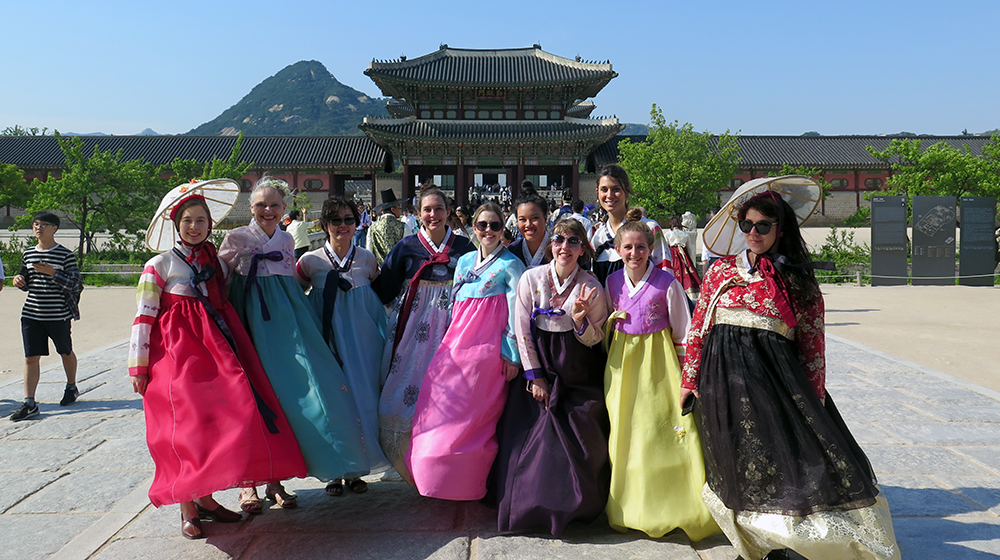SOC Students discover South Korea

The Global and Strategic Communication graduate program at Kyung-bok Palace, donning traditional Hanbok dress.
| July 11, 2019 |
|---|
What are K-Pop, K-Beauty and Hallyu?
How do you navigate a different culture that speaks another language and uses its own alphabet?
Students from Loyola’s School of Communication learned the answers to these questions and more during a two-week immersion trip to South Korea.
The SOC’s Global Strategic Communication Master’s Program took the 13-hour flight to Seoul, South Korea for a course titled Global Media and K-Culture. The two-week immersion was supervised by Dr. Pam Morris, Advertising and Public Relations Program Director, with assistance from Dr. Chris Yim, Assistant Professor.
Prior to travel, students investigated South Korea and prepared individual learning questions with topics as diverse as food and symbolism, culture, beauty and social media, advertising and public relations practices and trends. Knowledge and experiences were incorporated into final multimedia presentations the last day of classes and professional-style research papers due several weeks after return to Chicago.
The eight graduate students stayed at Ewha Womans University’s International House in Seoul’s Shinchon district. A treasure hunt to find three nearby landmarks was one of the first tasks and helped everyone become familiar with their new surroundings.

Students discovering historic Sinchon Station, one of Seoul’s treasures.
SOC students were integrated into several Korean classes. At Ewha Womans University students heard final Hospital of the Future class presentations.
Video of Dr. Seung Lee’s Hospital of the Future class presentations.
“Their ideas are things that I never would have imagined a hospital in the United States doing. Each group incorporated relevant and impactful information about issues and proposed a positive solution related to Korean culture and habits,” said student Liana O’Grady.
As fledging global communication practitioners, the class visited several public relations and advertising agencies, including Porter Novelli, Fleishman-Hillard and Cheil.

Visiting Seoul’s Fleishman-Hillard public relations agency.
Visit to Cheil, South Korea’s largest advertising agency and part of Samsung. Students from both Ewha Womans University and the SOC attended.
Koreans’ forward-thinking and technological sophistication was ever apparent, as student Lizzie Hoffman observed.
“The country is thriving in so many ways, and it is so exciting to see,” Hoffman said.
Students were able to experience more, including high definition VR television and the latest industry trends and tools, at KOBA, The 29th Korea International Broadcast, Audio & Lighting Equipment Show.
Students exploring KOBA.
While the group toured media organizations, such as JTBC Newsroom and MBC World, the highlight was watching Music Bank, a live television show of K-Pop, including Superhuman, Lovelys, The Boyz, and Eclipse, at KBS Studios. Seeing the choreographed efforts was exciting and demonstrated Korean’s collectivist society – harmonization of individuals. As K-Pop captures imaginations across the globe, it continues the Korean Wave, or Hallyu, and as a soft power, provides familiarity and national branding for the nation.
Students navigated subways, trains and buses and wandered through local markets. The adventures brought insights, as observed by student Lexi Tiller.
“I was impressed by the technology and subway system – a lot of thought was put into how it was laid out,” Tiller said.
Student Rebecca Dempsey agreed: “The level of respect I saw in the locals was incredible, from the cleanliness of their streets to their subways and parks, I was amazed every time.”
 Gwangjang Market.
Gwangjang Market.
The group learned about Korean food symbolism and eating traditions. Food’s bright colors, various textures, preparation styles and distinctive flavors are all meaningful and work together, again, reflecting the harmony of the collectivist society. Also observed are seating arrangements and roles at the table, such as filling one-another’s glasses – a sign of respect and social hierarchy.

Welcome dinner with Korean BBQ.
Historical and cultural visits, including the traditional architecture of Bukchon Hanok Village, changing of the royal guard at Derksugung Palace and a day-long trip to the Korean Demilitarized Zone (DMZ) were part of the itinerary. One of the most memorable afternoons was wearing a Hanbok while strolling around Kyung-bok Palace.

Traditional Hanbok dress at Kyung-bok Palace.
In today’s fast-paced global marketplace, learning to traverse and understand a different culture is necessary. This immersion stretched everyone out of their comfort zone and made them stronger.
As Rebecca Dempsey reflected, “I don't view this trip as a vacation, despite doing so many fun things. I view it as a test run for the future. If I could make it two weeks in Seoul navigating everything from the pharmacy and post office to menus, maps, and more, I think I would be able to make the jump, if given the opportunity, to work internationally in the future. This trip has given me an experience I wouldn't be able to find anywhere else.”
